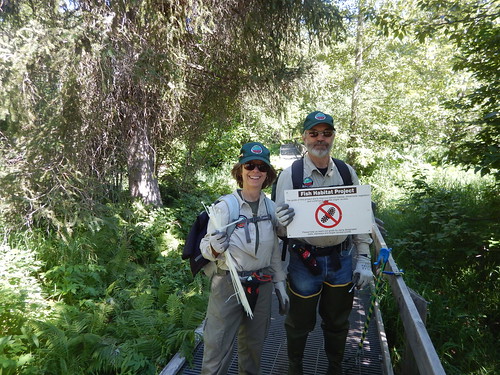
The river banks of the Upper Kenai and Russian Rivers in Alaska’s Kenai Peninsula are known to attract some of the most avid fishermen. In the last couple decades, they have also lured a growing number of citizen volunteers who are equally passionate about an environmental stewardship mission to protect them.
The diverse system of plants that grow along the two rivers and their stream beds control erosion and help filter and keep those waters clean. But over decades of use, the numbers of anglers visiting these special places have left their mark.
“In 1994, we had a small group of 10 concerned citizens who joined with the Chugach National Forest to protect the sensitive banks of the rivers by educating river visitors and installing critical habitat fencing along the river,” said Bobbi Jo Skibo, the forest’s interagency management coordinator for the Russian River. “Because of their passion, the volunteers and Forest Service together forged the Stream Watch volunteer program based on mutual interests.”
“A lot of anglers ‘loved these places to death’ and what happened was a lot of foot traffic and damage along the banks degraded all the plants to the point where there were just muddy banks, exposed roots and the sediment was going into the river and damaging the area for future generations of fish,” explained Skibo. “We needed boardwalks, trails, and river access points so the anglers wouldn’t damage the actual banks and the plants, but were able to access the river in a place that they wanted to fish.
Due to the success of the program and the growing need for river stewardship activities on the broader Kenai Peninsula, the Kenai Watershed Forum was approached in 2011 to jointly administer the program and to expand the focus to other high-use recreation sites.

During a typical summer season, volunteers spend more than 1,600 hours sharing river and cultural resource protection information with over 4,500 visitors including anglers, hikers, wildlife viewers and photographers. The volunteers remove up to 1,000 pounds of litter such as food and beverage containers and old and broken fishing gear from the river; install up to 5 miles of plant protection fencing and assist agencies in special projects such as removing barriers to fish passage like washed out bridges and culverts. In 2015, 100 pounds of fishing line were also removed.
“Since 1994, the program has become a volunteer-driven river protection force of 70-plus people that now protects and improves the Kenai, Russian and Kasilof Rivers,” said Skibo.
With help from the Forum, the program has extended beyond the forest to include state and local watersheds. Five official Stream Watch sites currently exist: the Russian River/Ferry Site, Bings Landing, Moose Range Meadows, Centennial Park, and the Kasilof River. Over time, the program may expand further.
“Stream Watch volunteers are passionate, dedicated and knowledgeable in sharing the key facts and messages that river visitors can use to make educated decisions to keep Kenai Peninsula rivers healthy,” said Skibo, “We are fortunate to have support and recognition form many agencies non-profits and businesses that ensure the program’s success every year. They can all be very proud that their work has improved river health for current and future visitors.”



